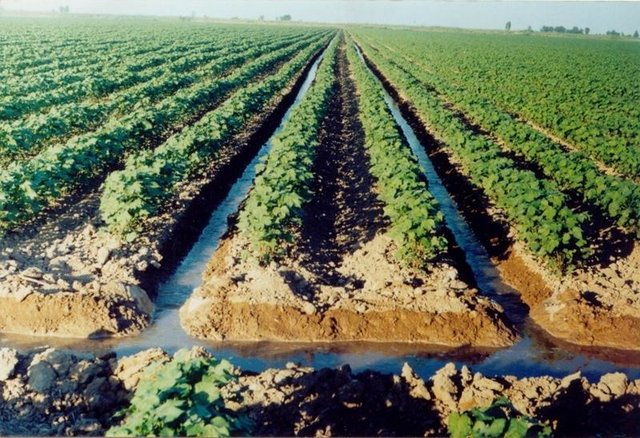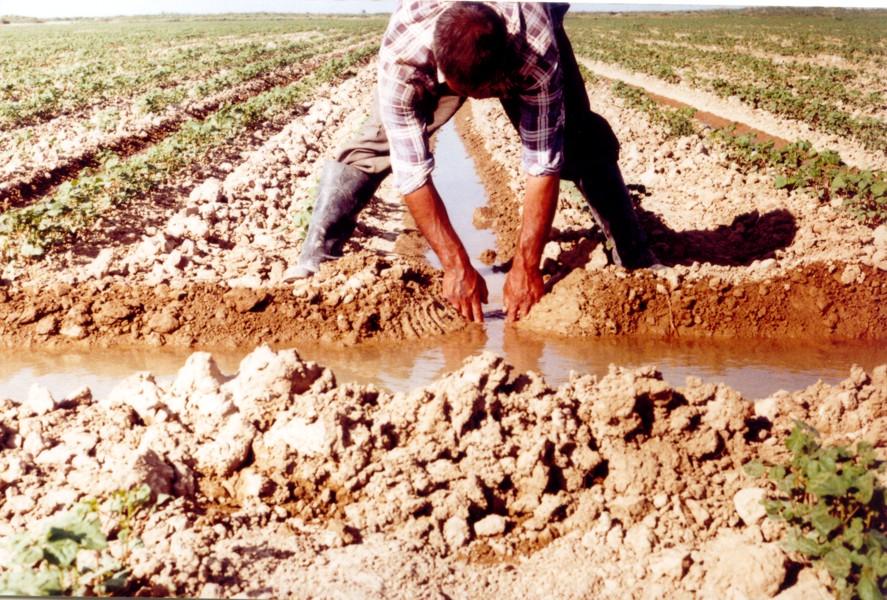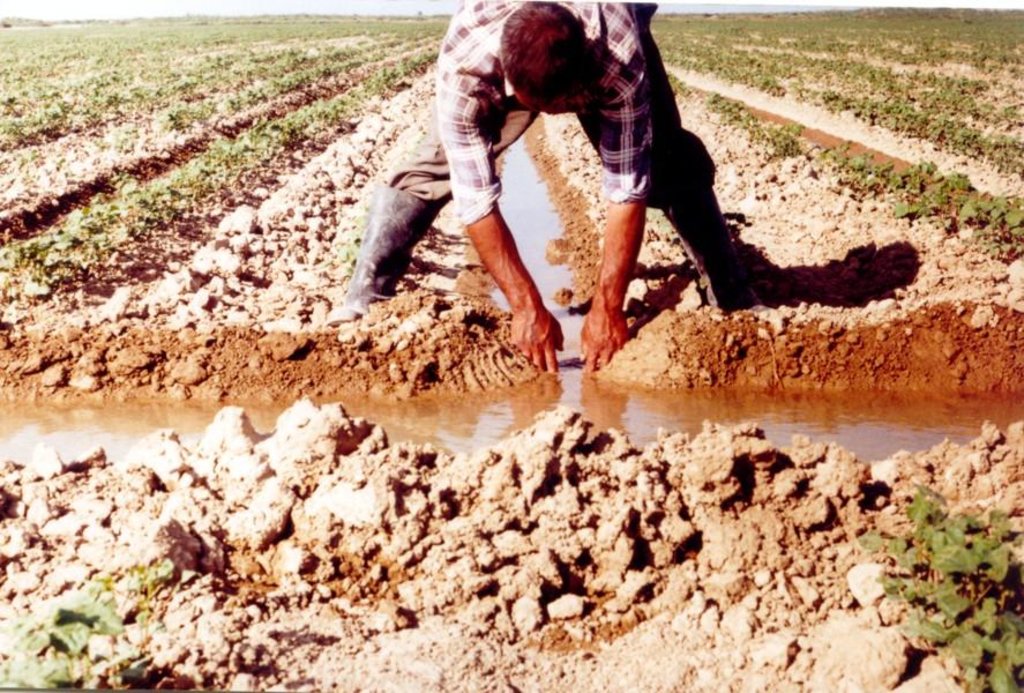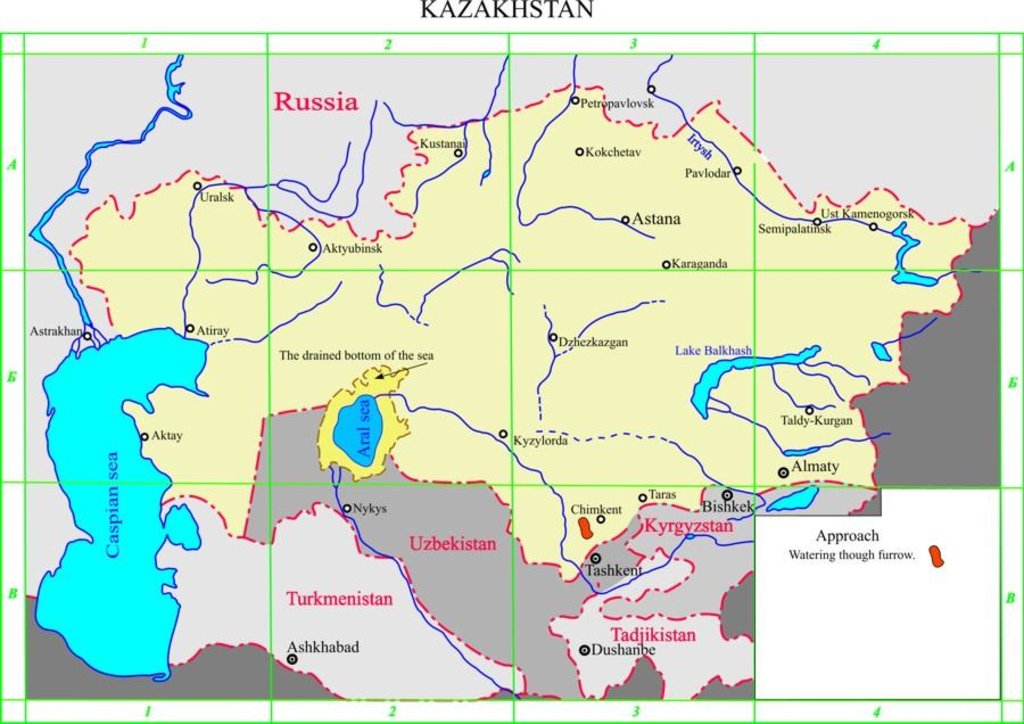Watering through furrow [Cazaquistão]
- Criação:
- Atualização:
- Compilador/a: Unknown User
- Editor: Hayot Ibrakhimov
- Revisores: Fabian Ottiger, Rima Mekdaschi Studer
approaches_2364 - Cazaquistão
Veja as seções
Expandir tudo Recolher tudo1. Informação geral
1.2 Detalhes do contato das pessoas capacitadas e instituições envolvidas na avaliação e documentação da abordagem
Pessoa(s) capacitada(s)
Especialista em GST:
Vyshepolskey Franc
2-47-78,
Kniv@nursat.kz
SRI for Water Management
12 Koigeldy str Jambul area, Taraz city 484022
Cazaquistão
Nome da(s) instituição(ões) que facilitou(ram) a documentação/avaliação da Abordagem (se relevante)
Kazakh Research Institute for Soil Science and Agr (Kazakh Research Institute for Soil Science and Agr) - Cazaquistão1.3 Condições em relação ao uso da informação documentada através de WOCAT
O/a compilador/a e a(s) pessoa(s) capacitada(s) aceitam as condições relativas ao uso de dados documentados através da WOCAT:
Sim
1.4 Referência ao(s) questionário(s) sobre tecnologias da GST

Water-conservation technology at cultivation of the cotton in … [Cazaquistão]
The technology of watering through furrow reduces the settlement (recommended) sizes of irrigating norms up to 30% keeps soil fertility
- Compilador/a: Unknown User
2. Descrição da abordagem de GST
2.1 Descrição curta da abordagem
Watering through furrow
2.2 Descrição detalhada da abordagem
Descrição detalhada da abordagem:
Aims / objectives: To the developing of irrigated agriculture in a valley of the river Syr-Darya is interfered the deficiency of water resources. The problem of stabilization of an agricultural production is solved due to using of the SWC approach 'watering through furrow'.
Methods: The approach provides a necessary level of accumulation of a moisture into the soils for reception of guaranteed crops. Water supply is carried out by means of watering through furrow on a farmlands from conditions of saturation of 1.5 meter layer up to a field moisture capacity. At absence of financing for reconstruction of irrigating system the water availability of the irrigated soils raises due to optimization of the watering elements. For this purpose on an irrigated field are laying furrows long 150-400 m., the distances between furrow can change from 0.7 up to 0.9 meter. Width of a furrow on top 35-40 sm., and depth from 12 up to 17 sm., depending on slope of surfaces of the ground. Experience shows that the effect of uniformity of humidifying of ground is reached at the consumption of water of 0.9 liter/sec (quantity of absorbing water in the end of furrow to absorbed volume in head). Depending on agromeliorative properties of soil, can vary from 1.1 up to 0.7 liter/sec. In view of control of a water stream at watering through furrow, make a reinforcing of headstalls of irrigating furrows by cellophane napkins (50*50sm), irrigation tubes. Watering through furrow allows to reduce the losses of water to a filtration in 2 times, on dump and evaporation in 1.5 times. Due to reduction of these losses it is possible to improve water-availability of other irrigated masses on 20-30%. The given approach allows to save water resources to apply widely technique, provides high germination and survival of cultivated cultures, and save a manpower. The soil-cultivating technique passes on dry furrow and provides high quality of interrow cultivating of soils. The waterier easily moves on a field (dry furrows) and carries out duly redistribution of water in furrows, that improves quality of watering, operating conditions of a drainage, raises uniformity of humidifying soils, reduces expanses of water for reception of unit of agricultural production.
2.3 Fotos da abordagem
2.5 País/região/locais onde a abordagem foi aplicada
País:
Cazaquistão
Região/Estado/Província:
Southern-Kazakhstan
2.6 Datas de início e término da abordagem
Indique o ano de início:
2000
2.7 Tipo de abordagem
- Tradicional/Indígena
2.8 Principais metas/objetivos da abordagem
The Approach focused on SLM only (Conjoining of humus horizone, deficiency of water, heavy loams, secondary salinization, filtration)
Water resources management and optimization of the watering superficial technologies of the irrigated grounds.
The SLM Approach addressed the following problems: 1. Water conservation 2. Maintenance of guaranteed crops
2.9 Condição que propiciam ou inibem a implementação de tecnologia/tecnologias aplicada(s) segundo a abordagem
Disponibilidade/acesso a recursos e serviços financeiros
- Inibitivo
Lack of mean for reconstraction of irrigating system
Treatment through the SLM Approach: Introduction of the SWC technologies
Quadro institucional
- Inibitivo
Absense of essential measures on water-division
Treatment through the SLM Approach: There are created the Regional structures-BWA (Basin Water Associations)
3. Participação e papel das partes interessadas envolvidas
3.1 Partes interessadas envolvidas na abordagem e seus papéis
- Usuários de terra/comunidades locais
Working land users were mainly men (Proprietors on the ground are basically men), Having small plots of the graunds (till 1 ha)
- Organização internacional
farms associations
3.2 Envolvimento do usuários de terra/comunidades locais nas diferentes fases da abordagem
| Envolvimento do usuários de terra/comunidades locais | Especifique quem estava envolvido e descreva as atividades | |
|---|---|---|
| Iniciação/motivação | Nenhum | |
| Planejamento | Passivo | public meetings, interviews/questionnaires |
| Implementação | Passivo | responsibility for minor steps; anxiety for the plots and for the future income |
| Monitoramento/avaliação | Nenhum | |
| Research | Nenhum |
3.4 Decisão sobre a seleção de tecnologia/tecnologias de GST
Especifique quem decidiu sobre a seleção de tecnologia/tecnologias a serem implementadas:
- Principalmente especialistas em GST, após consulta com usuários da terra
Explique:
The initiative of expertsof SRI (Scientific Research Institute)
Decisions on the method of implementing the SLM Technology were made by by SLM specialists alone (top-down). Development of the SWC land users
4. Suporte técnico, reforço das capacidades e gestão do conhecimento
4.1 Reforço das capacidades/ formação
Foi oferecida formação aos usuários da terra/outras partes interessadas?
Sim
Especifique quem foi capacitado:
- Usuários de terra
- politicians/decision makers
Tipo de formação:
- Em exercício
- Agricultor para agricultor
Assuntos abordados:
Geology, soil scince, ecological hydrology
4.2 Serviço de consultoria
Os usuários de terra têm acesso a um serviço de consultoria?
Sim
Descreva/comentários:
Advisory service is very adequate to ensure the continuation of land conservation activities; SRI has the qualified professionals carable to create service of training on places (farms)
4.3 Fortalecimento da instituição (desenvolvimento organizacional)
As instituições foram fortalecidas ou estabelecidas através da abordagem?
- Sim, moderadamente
Especifique a que nível (níveis) as instituições foram fortalecidas ou estabelecidas:
- Local
Especifique o tipo de apoio:
- Reforço das capacidades/ formação
4.4 Monitoramento e avaliação
Monitoramento e avaliação são partes da abordagem?
Sim
Comentários:
bio-physical aspects were ad hoc monitored through measurements
economic / production aspects were ad hoc monitored through observations
There were several changes in the Approach as a result of monitoring and evaluation: Ther were developed some approaches of management of a water stream in irrigating furrow by means of reinforcing its heads (cellophane napkins, irrigation tubes, siphons)
4.5 Pesquisa
A pesquisa foi parte da abordagem?
Sim
Especifique os tópicos:
- Ecologia
- Tecnologia
Dê mais detalhes e indique quem realizou a pesquisa:
For the varius types of soil there were developed the norms of watering, a mode of an irrigation of adricultural crops and optimization of technologies of superfisial watering
Research was carried out on-farm
5. Financiamento e apoio material externo
5.1 Orçamento anual para o componente de GST da abordagem
Caso o orçamento exato seja desconhecido, indique a faixa:
- < 2.000
Comentários (p. ex. principais fontes de recursos/principais doadores):
Approach costs were met by the following donors: government (national - Kazakhstan SRI): 95.0%; local community / land user(s) (Akimat): 3.0%; other (Separate farmers): 2.0%
5.2 Apoio financeiro/material concedido aos usuários da terra
Os usuários da terra receberam apoio financeiro/material para a implementação de tecnologia/tecnologias?
Sim
5.3 Subsídios para entradas específicas (incluindo mão-de-obra)
- Equipamento
| Especifique quais entradas foram subsidiadas | Em que medida | Especifique os subsídios |
|---|---|---|
| Maquinário | Parcialmente financiado | |
| irrigation net | Parcialmente financiado | |
Se a mão-de-obra pelos usuários da terra foi uma entrada substancial, isso foi:
- Voluntário
Comentários:
Interest of farms in reception of guaranteed crops
5.4 Crédito
Foi concedido crédito segundo a abordagem para atividades de GST?
Não
6. Análise de impactos e declarações finais
6.1 Impactos da abordagem
A abordagem auxiliou os usuários da terra a implementar e manter as tecnologias de GST?
- Não
- Sim, pouco
- Sim, moderadamente
- Sim, significativamente
The approach of watering through furrow, and also techniques on management of a water stream in furrows (film, napkins, tubes)
A abordagem melhorou as questões de posse de terra/diretos do usuário que inibiam a implementação das tecnologias de GST?
- Não
- Sim, pouco
- Sim, moderadamente
- Sim, significativamente
Did other land users / projects adopt the Approach?
- Não
- Sim, pouco
- Sim, moderadamente
- Sim, significativamente
State SPC, the Ministry of Agriculture recommends self-covernment institutions, coommittees of a Water Management and Agriculture to use developed by the SWC approach the norms of irrigating and applications of ways of reinforcing of irrigation furrows
6.3 Atividades de sustentabilidade de abordagem
Os usuários da terra podem manter o que foi implementado através da abordagem (sem apoio externo)?
- Sim
6.4 Pontos fortes/vantagens da abordagem
| Pontos fortes/vantagens/oportunidades na visão do usuário da terra |
|---|
| Opportunity of application of the SWC approach on various types of soil with a mode of humidifying (How to sustain/ enhance this strength: To give an explication of the soil as humidifying) |
| To duplicate (to expand) application of the SWC approach (How to sustain/ enhance this strength: To raise grants possibility) |
| Pontos fortes/vantagens/oportunidades na visão do/a compilador/a ou de outra pessoa capacitada |
|---|
| Loses of water to a filtration are reduced (How to sustain/ enhance this strength: Improvement of technologies of superficial irrigation) |
| Saves water consumption (How to sustain/ enhance this strength: Expansion of an area of application of the SWC approach) |
| Improves well-being of local population (How to sustain/ enhance this strength: Propagation of the SWC approach and training of farmers) |
6.5 Pontos fracos, desvantagens da tecnologia e formas de superá-los
| Pontos fracos/vantagens/riscos na visão do/a compilador/a ou de outra pessoa capacitada | Como eles podem ser superados? |
|---|---|
| The account of a slope of surface of allotments is insufficiently fulfilled | Creation of the maps of land using with the indicatin of a slope of surface |
7. Referências e links
7.1 Métodos/fontes de informação
- visitas de campo, pesquisas de campo
- entrevistas com usuários de terras
Links e módulos
Expandir tudo Recolher tudoLinks

Water-conservation technology at cultivation of the cotton in … [Cazaquistão]
The technology of watering through furrow reduces the settlement (recommended) sizes of irrigating norms up to 30% keeps soil fertility
- Compilador/a: Unknown User
Módulos
Não há módulos





